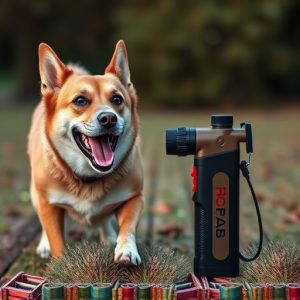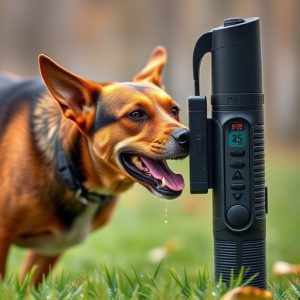Dog Pepper Spray: Legalities, Impact, and Responsible Use in Law Enforcement
Dog pepper spray, a non-lethal force option for law enforcement, uses capsaicin to control aggressiv…….
Dog pepper spray, a non-lethal force option for law enforcement, uses capsaicin to control aggressive dogs. Though banned or restricted in many US states due to concerns over misuse and animal welfare, it's proven effective for de-escalating high-risk situations without severe harm. Effective deployment requires comprehensive training, clear protocols, and adherence to legal standards, with special consideration given to varying canine reactions. Law enforcement must understand the legal nuances regarding dog pepper spray in their jurisdictions, especially restrictions in certain states, to use this tool responsibly as a last resort.
“Unleashing a powerful tool in law enforcement, canine pepper spray has emerged as a controversial yet effective solution for handling aggressive dogs. This article delves into the world of police-grade dog pepper spray, exploring its formulations, impact on canine behavior, and legal considerations. With varying restrictions across states, understanding when to deploy this tactic is crucial. From benefits and safety protocols to responsible training practices, we dissect the nuances, shedding light on the use of dog pepper spray while navigating restricted states.”
- Canine Pepper Spray: An Overview of Police-Grade Formulations and Their Impact on Dog Behavior
- Understanding the Legal Landscape: Which States Restrict the Use of Dog Pepper Spray?
- Benefits and Considerations: When Might Police or Security Professionals Opt for Canine Pepper Spray?
- Safety and Training: Essential Protocols for Effective and Responsible Deployment in Law Enforcement
Canine Pepper Spray: An Overview of Police-Grade Formulations and Their Impact on Dog Behavior
Canine pepper spray, also known as dog pepper spray or capsaicin-based spray for dogs, is a controversial yet powerful tool used by law enforcement agencies for specific canine control scenarios. It’s a restricted substance in many states due to its potency and potential for misuse, but it has proven effective in certain police operations. The formulations vary from standard pepper spray to specialized dog-specific blends designed to immobilize or deter aggressive dogs without causing severe harm.
These police-grade dog pepper sprays contain capsaicin, the compound responsible for the burning sensation associated with chili peppers. In controlled doses, it can temporarily blind and disorient a dog, enabling officers to gain control of an unruly animal during high-risk situations. The impact on canine behavior varies; some dogs may become temporarily paralyzed or require assistance due to respiratory distress, while others might exhibit increased aggression or anxiety post-exposure. Therefore, proper training and adherence to safety protocols are crucial when using this equipment to ensure both officer and canine safety.
Understanding the Legal Landscape: Which States Restrict the Use of Dog Pepper Spray?
In the United States, the legal landscape surrounding canine pepper spray, also known as dog pepper spray or capsaicin spray, varies significantly from state to state. While some states have embraced its use by law enforcement for crowd control and animal control purposes, others have implemented stringent restrictions or outright banned it. Understanding these legal nuances is crucial when considering the purchase and deployment of dog pepper spray.
Among the states that restrict the use of dog pepper spray are California, New York, and Illinois. These jurisdictions have stringent laws governing the use of chemical agents by law enforcement, often requiring specific training, authorization, and adherence to strict protocols. For instance, California’s Health and Safety Code Section 25402 prohibits the sale or transfer of capsaicin spray without a license, while New York has strict guidelines on its use, primarily limiting it to emergency situations. Such restrictions aim to protect citizens from potential harm and ensure that pepper spray is employed responsibly and in accordance with the law.
Benefits and Considerations: When Might Police or Security Professionals Opt for Canine Pepper Spray?
Canine pepper spray, a specialized tool for law enforcement and security professionals, offers several advantages in certain high-risk situations. Its non-lethal nature makes it a preferred option when de-escalation is crucial but physical force might be necessary. The spray can temporarily incapacitate an individual, providing the team with valuable time to control the scene or detain suspects safely without causing permanent harm.
Choosing to deploy canine pepper spray requires careful consideration. It is primarily restricted in some states due to concerns over animal welfare and potential misuse. Security professionals must assess the threat level, crowd dynamics, and the presence of vulnerable individuals before deciding to use this method. In situations involving aggressive or unpredictable subjects, where other non-lethal force options may be ineffective, dog pepper spray could be a strategic choice for maintaining control and ensuring public safety.
Safety and Training: Essential Protocols for Effective and Responsible Deployment in Law Enforcement
The safe and responsible deployment of canine pepper spray, also known as dog pepper spray, is paramount in law enforcement operations. Before using this powerful tool, officers must undergo rigorous training to ensure they understand the potential risks and benefits. Proper training includes learning how to assess a situation, select the appropriate pepper spray type, and master the techniques for effective deployment while minimizing harm to both suspects and bystanders. This involves understanding the range of effects, de-escalation strategies, and post-application care for those exposed.
In addition to individual training, departments must establish clear protocols and policies governing when and where dog pepper spray can be used, especially considering its restricted status in certain states. These guidelines help ensure that officers use it only as a last resort when other de-escalation methods have failed, and they follow specific criteria for its application. Regular reviews and updates of these protocols are crucial to keeping up with best practices and evolving legal standards regarding the use of force, including canine pepper spray.
In conclusion, while dog pepper spray offers tactical advantages for law enforcement and security professionals, its use is not without legal or ethical considerations. With varying restrictions in place across different states, it’s crucial to understand the impact of police-grade formulations on canine behavior. When employed responsibly and under appropriate protocols, these products can aid in crowd control and dangerous situation management. However, ongoing dialogue and research are essential to ensure their safe and effective deployment while respecting animal welfare standards.


